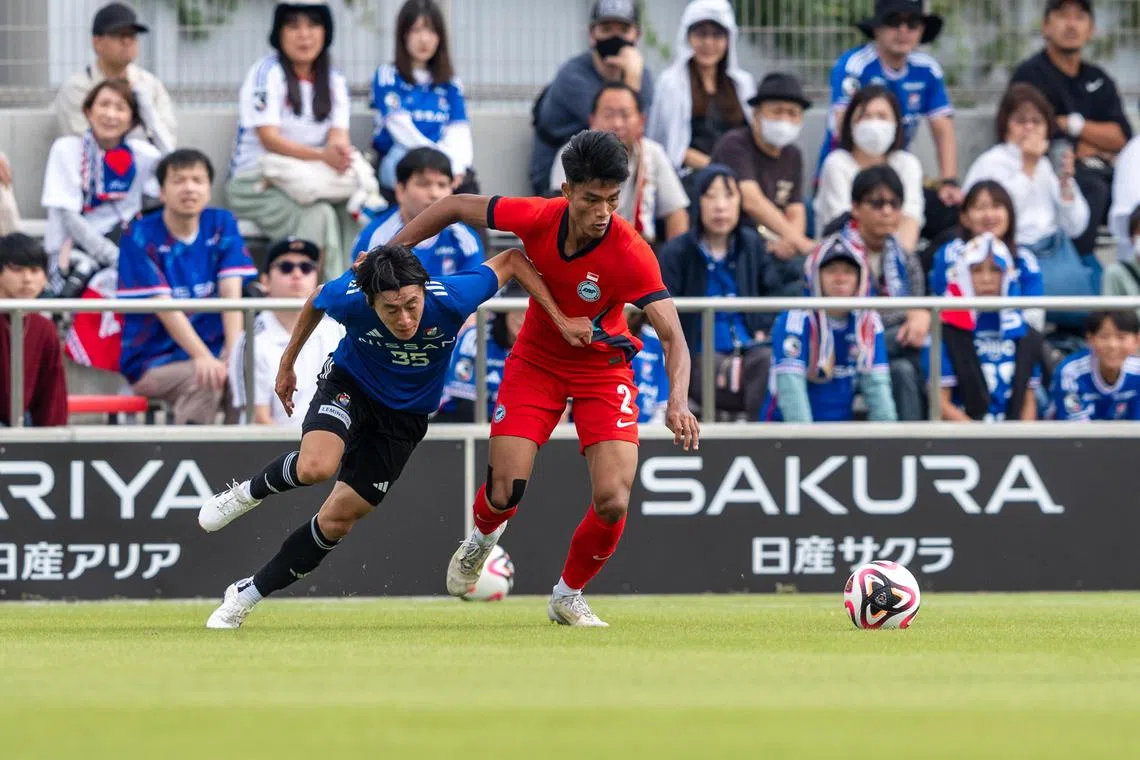Dream is for Singaporeans to play in Japan’s J2 and J3 clubs, says football chief Bernard Tan
Sign up now: Get ST's newsletters delivered to your inbox

Uncapped Lions right-back Raoul Suhaimi (right) impressed in the 7-1 loss to J1 League side Yokohama F. Marinos and aspires to play in Japan one day.
PHOTO: FAS
Follow topic:
YOKOHAMA – As with anything that involves competitive sport, one has to play with and against the best to become better.
Playing in friendlies against Japanese top-tier clubs FC Tokyo, Tokyo Verdy and Yokohama F. Marinos, the Singapore national football team – players and backroom staff included – discovered first-hand the gap between themselves and some of the best in Asia.
The intense pace, power and physicality, along with the high level of preparation and professionalism, are some of the things they have learnt over the 10-day training camp in Japan.
The Singapore Premier League does not have these qualities at the moment, and that is why Football Association of Singapore president Bernard Tan is looking to the Land of the Rising Sun to help lift local football.
During the Lions’ training stint, he met several clubs from all three divisions of Japan’s professional league to “see how our best coaches, youths and players can have meaningful opportunities to join the Japanese ecosystem and develop within it”.
The idea is for “long attachments” of at least one year, as he told The Straits Times: “While we work to develop our own ecosystem in Singapore, we need to move our best – coaches and players – overseas so that we can steepen that development curve.
“For our best players, the dream is for the men to have the opportunity to play professionally for at least a J2 or J3 club, and for the women to play in the Women Empowerment League.”
If the lower-tier clubs are unable to offer lucrative salaries, “we will see how we can assist the players and coaches with their living expenses to continue their education”, he added.
The J-League has partnership agreements with Thailand, Indonesia, Vietnam, Myanmar, Cambodia, Singapore and Malaysia.
From 2019, J-League clubs can sign players from these seven countries with no import quota restriction.
Since the J-League started in 1993, close to 50 players from eight South-east Asian countries have joined clubs from the top three divisions.
But, besides Thais Chanathip Songkrasin and Theerathon Bunmathan, who played in more than 100 J-League matches, no other player managed to clock 10 or more J-league appearances.
Similarly, while Singapore have had male and female footballers attached to Japanese sides – Anders Aplin joined Matsumoto Yamaga on loan in 2018 and Rosnani Azman signed for INAC Kobe Leonessa in 2021 – they did not make an impact.
Marinos management director Nobuhiko Yoshino noted that perhaps talented left-footed players from South-east Asia could make more inroads as this is a quality the J-League lacks.
The club signed left-back Theerathon in 2019 after being impressed by his performances with Vissel Kobe and he won the league that year – a first for a footballer from the region.
When he left after the 2020 season, he had four goals and 11 assists from 94 games for Marinos.
Similarly, Verdy signed Indonesia left-back Pratama Arhan in 2022. However, he played just two J2 League games in two years.
Verdy sports director Atsuhiki Ejiri said: “South-east Asian players may have good individual qualities like dribbling or shooting, but they lack knowledge about attacking and defensive organisation as a team.
“This has to be learnt from a young age at the academies, and by the time they turn professional, they can go to different teams, adapt quickly and know what to do.
“Otherwise, they will find it hard to fit in, or their team will find it hard to beat stronger teams.”
Tan acknowledges this gap and hopes to bridge it through long-term youth player attachments to J-League clubs, which could come under the Unleash The Roar! national football project that has already sent youngsters to Spain and the United States.
He shared that Japan could launch a professional youth league in 2026, which “may offer special opportunities for us”.
Tan envisions a “mutually beneficial” engagement that also provides opportunities for Japanese clubs, coaches and players to benefit from the Singapore ecosystem, pointing to Albirex Niigata – which features Japanese players and coaches – in the Singapore Premier League.
He added: “At the club level, we need them to be more familiar with the Singapore system and appreciate our coaches and players.
“We want them to take our people in their clubs on merit and allow them to integrate fully. Special ring-fenced programmes will not allow us to benefit from the ecosystem fully.
“We want them to be fully integrated, and on our end, our boys and girls need to make an effort to learn at least spoken Japanese.
“In turn, we can see how we can help the Japanese develop the visibility of their leagues in Singapore.
“We will continue to invite them to play friendly tournaments in Singapore, welcome them to conduct clinics and trials in Singapore for the region, and explore opportunities for their personnel to join our ecosystem – again on merit.”
After playing in the three friendly games, uncapped Lions right-back Raoul Suhaimi is inspired to earn a move to Japan.
The 19-year-old said: “The Japanese players are better in terms of technique, speed and intensity, and it was a good experience for us to learn from them because we don’t often get to play against opponents of this quality.
“I have always wanted to play overseas as I believe it will help me become a better player...
“I will keep working hard for the opportunity and be ready for the challenge when the time comes.”

